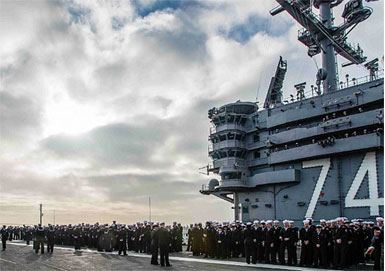The first Navy ships running partially on biofuels as part of everyday operations are at sea after leaving San Diego.
The ships are part of the Navy’s Great Green Fleet – its effort to convert to much more efficient ships that run on renewable fuels. While initial fuel blends contain only 10% biofuels, they are on track for 50/50 blends as prices come down, they say.
The Navy’s goal is to get half its fuel from renewable sources by 2020.
A blend of waste fats, they are considered "drop in" fuels as they can be used without any change to a ship’s engine, transport equipment or operational procedures. And, as instructed by Congress, they are cost-competitive with fossil fuels.
Midwest cattle farmers and ranchers sell waste beef fat to California-based AltAir Fuels, which blends it with diesel and then sells it to the Navy under a contract for $2.05 a gallon.
Sailors prepare to board the USS John C. Stennis for regularly scheduled deployment from San Diego, this time with biofuels:

Republicans tried to block the use of biofuels because they cost $15 per gallon when the Great Green Fleet held its first demonstration, but since then prices have declined substantially as Mabus expected.
While Republicans still say it’s a waste of money, Mabus disagrees. "We absolutely have to have – particularly in this constrained budget environment – a stably priced, domestically produced alternative to fossil fuels that don’t spike based on world crises. Every time the price of oil goes up $1 per barrel, it costs the Navy an extra $30 million."
To boost production, the Navy awarded $210 million to three companies that are building biorefineries at Department of Defense facilities. They come online this year, with full production in 2017 using cooking grease and oil and other feedstocks that don’t depend on cropland.
On the efficiency side, advances include dashboards that show how much energy is being consumed, stern flaps that reduce drag and the use of LED lighting greatly reduces energy demand.
Greater efficiency gives the Navy and Marines great advantages – they can stay longer without refueling, for example. "It gives us a strategic advantage," says Mabus. "Diversifying our energy sources arms us with operational flexibility and strengthens our ability to provide presence, turning the tables on those who would use energy as a weapon against us. We won’t be at the mercy of fluctuating oil prices and oil-producing nations.
"In 2010, we were losing too many marines in convoys carrying fossil fuels to outposts in Afghanistan, and the prohibitive cost of oil was requiring us to stop training at home in order to keep steaming abroad, a dangerous and unsustainable scenario," Mabus explains. Some ships are now electric-diesel hybrids.
Since 2009, when the program began, the Navy has cut oil consumption 15% and the Marine Corps, 60%. The Navy consumes about 25% of the 14 million gallons of fuel used by the Defense Department every day – the world’s biggest energy consumer – according to the Defense Logistics Agency.
The Great Green Fleet honors President Teddy Roosevelt’s Great White Fleet, which helped usher in America as a global power. This time it ushers in an era of energy innovation in the Navy and Marines, they say.
Read our articles, US Navy Says Biofuels Are New Normal.
